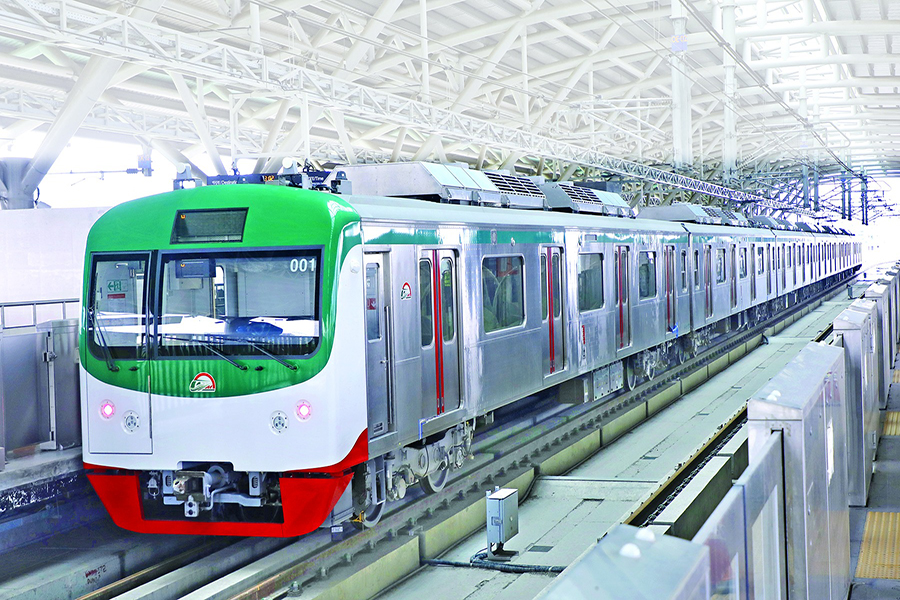Global experience exposes Achilles’ heel in Dhaka metro
Fault-lines found in design, construction, safety checkup
Fatal accident in overhead rail communications in crammed capital city provokes call for fixing contractor responsibility

Published :
Updated :

Beating global experience of once in 20 years, mishaps occurred twice over a year in Dhaka metro rail that raised doubts about the construction and safety qualities of the popular mass transport.
Experts are raising questions over not only design or construction faults but also deploring a shocking lack of proper maintenance and safety since its launch three years ago.
According to metro-rail experts, officials and consultants, operation of the Mass Rapid Transit line 6 (MRT 6) was launched on December 30, 2022 sans safety-clearance certification, and its regular safety audit was not conducted during the last three years ignoring the Metro Rail Act.
They also blame the authorities concerned for not appointing a third- party inspector although proposal was placed on different occasions for a lack of capacity of the implementing agency.
"Proposal given to inspect design of the MRT 6 at the design and construction stages was not accepted by the then DMTCL management. Same demand came at the time of inauguration and first accident of bearing-pad fall last year," an insider in the project told the FE writer
The second accident of bearing-pad breakdown from the pier 433 on Sunday noon killed a pedestrian on the spot while crossing the footpath on the Krishibid Institute side. Earlier accident occurred on 430 piers on September 19, 2024 without any casualty.
According to the MRT Act 2015, Dhaka Transport Coordination Authority (DTCA) as a regulatory authority is authorised to conduct the safety audit and regular inspection of the metro-rail operation.
However, neither did the Dhaka Mass Transit Company Limited (DMTCL) 's former Managing Directors allow them nor has the current management of the state-owned dedicated company given importance on the letters with the request sent by the DTCA several times.
The then government formed the DTCA as a coordinator and regulator in 2012 specially to study metro-rail corridors, proper functioning of the highly technical modern electrical-train-based mass transit, but it never worked to strengthen the capacity as a regulator and for better coordination, the sources said.
Even after both accidents, DTCA was not included in the committees formed to investigate and informed of any decisions or actions taken so far, the FE was confirmed.
Talking to different sources, the FE reporter found out that road transport and highways division had once conducted inspection through forming an 11- member committee comprising members from Bangladesh Railways and Roads and Highways Department. But none could find it.
Asked about Sunday's accident and what action DTCA has taken, its Executive Director Nileema Akter said, "A DTCA observation report will be prepared soon as a team has been working on after inspection of the area and accident spot."
She, however, said the company in a letter asked the DMTCL before the accident to conduct safety audit through a third party.
But an engineer who worked on metro rail in different countries also points out that inspection by a third-party design checker is a common practice in metro rail to ensure safety at the design stage. "But there was not such report on the MRT 6 at the initial stages."
He also raises another point of taking over certificate by the employer before the launch of the metro rail and says the DMTCL does not have such skilled manpower to take over each and every stage of design and construction
The MRT 6 was launched forcibly from Uttara to Agargaon before completing entire 20.1-kilometre corridor to use the project as Sheikh Hasina's Awami League government success before the 2024 January election.
A Japanese consultant at that time told the FE that they were forced to compromise engineering demand in the wake of traffic demand of Dhaka city's unbearable congestion.
A project-insider also admits it and says metro-rail operation was launched without sufficient trial-and test run.
"Ten per cent of trial run and blank run of trains were not conducted before the launching which would help resolve all technical problems like unusual shakings, undershoot and overshoot of train operation being faced by the DMTCL," he told the FE.
According to consultants, trial runs are conducted to show consultants and contractors each other problems facing after completing entire construction. But the blank runs for at least six months are operated without passengers to resolve integration problems by operating trains like regular basis.
Another engineer, preferring not to be named, also pointed out that the DMTCL's inadequacy in skilled manpower failed to check each and every works of the design and construction stage.
He said this was necessary to receive taking over certificate from the project's supervision consultant before launching the operation.
Due to lack of skills in DMTCL and related reports, engineers also said, it would not be possible for the government-formed investigation committee to find real cause of displacement of bearing pads by checking every work of design and construction.
"The committee cannot review each and every work of the design and construction work even if they predict any fault in reality," he said, also recommending need for third-party inspection through an independent international organization.
He also stressed forming an independent safety commission of the country's own to prevent further accidents.


 For all latest news, follow The Financial Express Google News channel.
For all latest news, follow The Financial Express Google News channel.